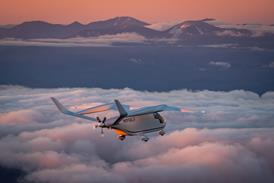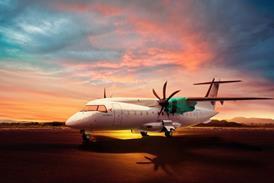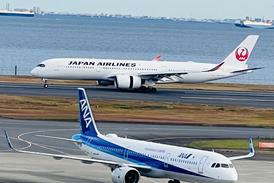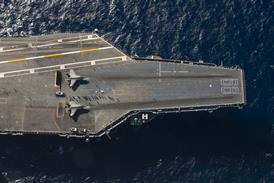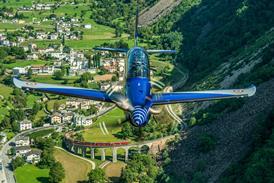By Michael Pliskin at Edwards Air Force Base
The US Air Force is testing synthetic fuel on a B-52 in a bid to reduce reliance on imported petroleum. Success will mean the fuel could be in service by 2008
Shortly after sunrise on a cool September morning in California’s Mojave Desert, a US Air Force Boeing B-52H rolled down the main runway at Edwards AFB on a historic first flight.
Three of the four twin-engine pods under the bomber’s wing belched the black smoke that is characteristic of this 1950s-era designed aircraft. Engines 7 and 8, in the outboard pod on the right wing, produced only half the smoke of the other engines. These two were burning a 50-50 blend of standard JP8 jet fuel and a synthetic Fischer-Tropsch (F-T) fuel. The other six engines were using standard JP8. It was the first time that a synthetic fuel had been flight tested in a US military aircraft and the latest step in a programme begun by the USAF earlier this year with the objective of a test flight before the end of September.
|
|---|
The two outboard engines on the B-52s right wing produced 50% less smoke while burning the synthetic fuel |
An outrigger landing-gear malfunction caused an early abort of the flight, so the full battery of tests, expected to last up to 4h, was not completed. However, the initial results from the take-off and short-duration flight looked promising, according to the USAF.
Two or three further test flights are planned, with sorties lasting up to 10-12h. The flight envelope will include altitudes up to 40,000ft (12,200m) at low, medium and high speeds and in-flight engine restart. Fuel flow will be tested at various load factors from zero to 1.8g to see how inlet airflow affects the fuel combustion. Throttle transients from quick snaps to slow variations will be tried to test engine response with the synthetic fuel blend. Eventually, cold weather performance will be tested either in Minot, North Dakota or in Alaska.
The engines being tested with the new fuel are standard Pratt & Whitney TF33 B-52 powerplants. The only modifications to be made were the installation of sensors for testing. Other than that, the engines, fuel pumps and other components are no different to the standard components on the B-52H.
Clean burning
The process for manufacturing the synthetic fuel used in these tests was first developed by German scientists Franz Fischer and Hans Tropsch in the 1920s. It was used extensively by the German armed forces during the Second World War because Germany had little access to petroleum, but an abundance of coal. The F-T process allows hydrocarbon fuel to be synthesised from coal, natural gas or biomass sources. The resulting fuel contains little or no aromatics and burns cleanly, emitting little sulphur or other pollutants.
Because the F-T fuel contains no aromatics, it does not cause engine system O-rings and seals to expand during operation, the way that normal JP8 fuel does. Therefore, it was decided to test the engines using a 50-50 blend with JP8 so that the engine systems could be operated without modification. Standard fuel additives were used in the mix for static dissipation, ice and corrosion inhibition and anti-oxidation.
After Hurricanes Katrina and Rita in 2005, US defence secretary Donald Rumsfeld ordered the armed services to begin a search for domestic sources of energy that did not require foreign petroleum. The government and commercial airlines of South Africa have been using Fischer-Tropsch fuels since 1999, while the UK Ministry of Defence has issued Defence Standard 91-91 approving the use of F-T fuels by its armed forces.
High cost
USAF undersecretary Dr Ron Sega, who was on board the B-52H for the synthetic-fuel test flight, says: “We are making energy a consideration in everything we do.” He says the USAF currently has four bases running entirely on renewable energy. “The air force is number one in the country and number three on the planet in purchases of renewable energy. Energy is a key design factor in new buildings.”
But the real issue is aviation fuel, which Sega says accounts for 80% of the USAF’s energy bill. The synthetic fuel programme is part of a sustained research effort that includes more efficient engines and airframes. Even the fuel truck that delivered the F-T/JP8 blend to the B-52H test aircraft was running on an F-T diesel blend.
After an analysis of available synthetic fuel technologies, the F-T process looked the most promising because of its maturity. The engines to be tested were first run with pure JP8 to get operating baselines. Then various mixes of JP8 and F-T fuels were tested before it was decided to use a 50-50 blend.
The first small-scale test involved a Rolls-Royce T63 helicopter engine on a test stand in a laboratory. Once those tests were complete, a B-52 engine was tested with the new fuel blend on a stand at Tinker AFB in Oklahoma. A battery of tests was completed including a 50h endurance run.
Following these tests, the engine was taken apart to look for signs of corrosion and deposits on inner components. It was found that the F-T/JP8 blend resulted in less coking, fewer harmful deposits on the engine components and a 20-40% reduction of emissions such as sulphur dioxide. The TF33 engine was then stand-tested at Edwards for throttle response, thrust, fuel flow and basic engine performance. Finally, after all those tests were completed, it was time to take the first flight.
Gen Curtis Radke, commanding officer of Edwards flight test centre, says the goals of this first test were to determine the effect of the F-T blend on the B-52’s fuel system and the TF33 engine, and to compare actual performance with that of engines running on pure JP8. Among the parameters being tested in flight were cold and warm starts, steady-state and variable-state thrust, fuel consumption, exhaust emissions and maintainability of the hardware.
The B-52 was chosen as the test platform because it has fuel tanks that can be isolated to feed particular engines. This way, one tank can be filled with the F-T/JP8 blend for the test engines, while the rest of the tanks carry standard JP8. After the flights, the engines, fuel pumps, lines and valves will again be inspected for coking, corrosion and other possible abnormalities. In about two months, a full eight-engine test of the F-T/JP8 blend will be flown to certify the fuel for use by the air force.
Availability
Among the other issues being discussed are fuel availability, storage and supportability (including whether the fuel blend is mixed on or off base). According to the US Defense Logistics Agency, the synthetic fuel has the same basic storage and logistics characteristics as JP8. By 2008 it is possible that both the USAF and navy could each acquire up to 380 million litres (100 million US gal) of synthetic fuel once the certification tests are complete.
The US DoD allocated a $3.6 million budget for the programme for fiscal year 2006. Of that, $2.6 million is for fuel allocation and the balance for research. The US Department of Energy also contributed $300,000 towards the project.
Although testing of synthetic fuel for commercial aircraft is outside the realm of the current tests, the data derived from this programme will be passed on to the other US military services and the commercial airlines.
Source: Flight International

